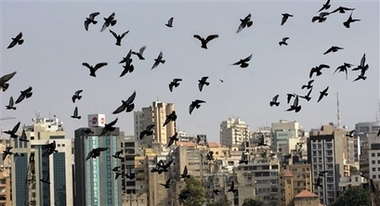 DAY 9, BEIRUT, Lebanon - Pitched battles raged between Israeli forces and Hezbollah fighters on the border Thursday, and Israel warned hundreds of thousands of people to flee southern Lebanon "immediately," preparing for a likely ground offensive to set up a buffer zone. U.N. chief Kofi Annan warned of a humanitarian crisis in Lebanon and called for an immediate cease-fire, even as he admitted "serious obstacles" stand in the way of even easing the violence. Annan denounced Israel for "excessive use of force" and Hezbollah for holding "an entire nation hostage" with its rocket attacks and snatching of two Israeli soldiers last week.
DAY 9, BEIRUT, Lebanon - Pitched battles raged between Israeli forces and Hezbollah fighters on the border Thursday, and Israel warned hundreds of thousands of people to flee southern Lebanon "immediately," preparing for a likely ground offensive to set up a buffer zone. U.N. chief Kofi Annan warned of a humanitarian crisis in Lebanon and called for an immediate cease-fire, even as he admitted "serious obstacles" stand in the way of even easing the violence. Annan denounced Israel for "excessive use of force" and Hezbollah for holding "an entire nation hostage" with its rocket attacks and snatching of two Israeli soldiers last week.
As the death toll rose to 330 in Lebanon as well as at least 31 Israelis, Lebanese streamed north into the capital and other regions, crowding into schools, relatives' homes or hotels. Taxi drivers in the south were charging up to $400 per person for rides to Beirut
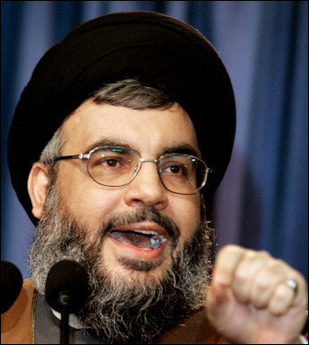 After more than a week of punishing Israeli aerial and artillery strikes, Hizb'allah chief Hassan Nasrallah says his group is easily absorbing all that Israel has thrown at it, and continues to successfully control the direction of the current fighting.
After more than a week of punishing Israeli aerial and artillery strikes, Hizb'allah chief Hassan Nasrallah says his group is easily absorbing all that Israel has thrown at it, and continues to successfully control the direction of the current fighting.
In an interview with Al Jazeera, Nasrallah firmly denied Israeli reports that some 50 percent of Hizb'allah's fighting capabilities have been eliminated by the IDF, and said his group remains as strong as ever and is ready to unleash more "surprises."
"All of the reports of the Israelis, that they struck 50 percent of our capabilities, are not true. They didn't succeed up to now in hitting anything in this range. Hizb'allah up to now has stood firm, it is succeeding in absorbing the attacks, in returning its own attacks, and it will return more in the future."
He also said Israel had failed miserably in its effort to decapitate the Hizb'allah leadership when it dropped some 20 tons of bombs on a Beirut bunker Wednesday night.
"The Hizbullah leadership wasn't hit at all - not in yesterday evening's attack. There was a huge number of planes and they hoped they would hit us but it was wrong."
With its leadership and fighting capabilities intact, Nasrallah suggested it is Hizb'allah that is controlling the direction of this war.
DAY 8, BEIR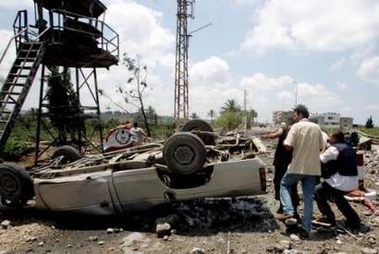 UT -- At least 55 Lebanese civilians were killed as Israeli warplanes pounded the capital and countryside, making today the deadliest day in a week of attacks and pushing this country's civilian death toll to more than 300. Fearful Westerners fled the country in droves.Violence also struck northern Israel, where two children were killed in a rocket attack in the town of Nazareth.
UT -- At least 55 Lebanese civilians were killed as Israeli warplanes pounded the capital and countryside, making today the deadliest day in a week of attacks and pushing this country's civilian death toll to more than 300. Fearful Westerners fled the country in droves.Violence also struck northern Israel, where two children were killed in a rocket attack in the town of Nazareth.
For the first time since fighting erupted last Wednesday, killing eight Israeli soldiers, Hezbollah fighters and Israeli troops engaged in a deadly border clash today. Two Israeli soldiers were killed and one guerrilla was killed, the Israeli army said. The clash took place near the Israeli border farming community of Avivim, north of Safat, and continued for several hours.
The deaths bring Israeli military losses to 14 soldiers and sailors over eight days, a toll comparable to those during the height of the Palestinian uprising, or intifada, that began in 2000.
In recent days, small contingents of Israeli ground forces have been operating along the frontier to demolish Hezbollah outposts and clear terrain, but there has been no large-scale movement of troops. However, the border zone began to reflect more signs of an Israeli military buildup. Tank carriers lumbered northward on roads heading to the frontier.
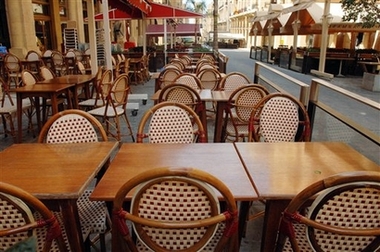 BEIRUT, 19 July (IRIN) - Lebanon's dream of 2006 as a record year for economic growth has in the space of a week turned into a nightmare. Israeli air strikes have brought its fast-growing economy to an almost complete standstill. With thousands of nationals and foreign workers evacuating, and more than 500,000 internally displaced people, a bleak scenario confronts the country's workforce. "The direct losses are estimated to be nearly half a billion US dollars," said Jihad Azoor, Lebanon's Finance Minister. "But we have to read this number carefully because we have no way of assessing the situation fully to get an accurate estimate. And more losses occur by the hour."
BEIRUT, 19 July (IRIN) - Lebanon's dream of 2006 as a record year for economic growth has in the space of a week turned into a nightmare. Israeli air strikes have brought its fast-growing economy to an almost complete standstill. With thousands of nationals and foreign workers evacuating, and more than 500,000 internally displaced people, a bleak scenario confronts the country's workforce. "The direct losses are estimated to be nearly half a billion US dollars," said Jihad Azoor, Lebanon's Finance Minister. "But we have to read this number carefully because we have no way of assessing the situation fully to get an accurate estimate. And more losses occur by the hour."
Khazen History


Historical Feature:
Churches and Monasteries of the Khazen family
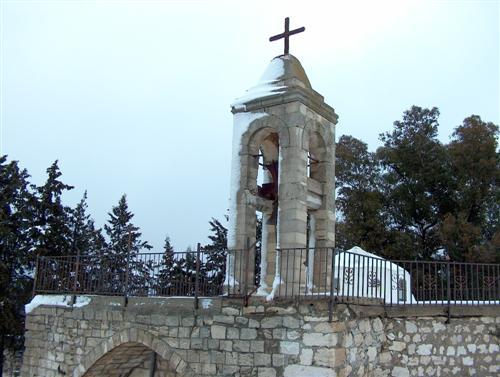
St. Anthony of Padua Church in Ballouneh
Mar Abda Church in Bakaatit Kanaan
Saint Michael Church in Bkaatouta
Saint Therese Church in Qolayaat
Saint Simeon Stylites (مار سمعان العامودي) Church In Ajaltoun
Virgin Mary Church (سيدة المعونات) in Sheilé
Assumption of Mary Church in Ballouneh
1 - The sword of the Maronite Prince
2 - LES KHAZEN CONSULS DE FRANCE
3 - LES MARONITES & LES KHAZEN
4 - LES MAAN & LES KHAZEN
5 - ORIGINE DE LA FAMILLE
Population Movements to Keserwan - The Khazens and The Maans
ما جاء عن الثورة في المقاطعة الكسروانية
ثورة أهالي كسروان على المشايخ الخوازنة وأسبابها
Origins of the "Prince of Maronite" Title
Growing diversity: the Khazin sheiks and the clergy in the first decades of the 18th century
Historical Members:
Barbar Beik El Khazen [English]
Patriach Toubia Kaiss El Khazen(Biography & Life Part1 Part2) (Arabic)
Patriach Youssef Dargham El Khazen (Cont'd)
Cheikh Bishara Jafal El Khazen
Patriarch Youssef Raji El Khazen
The Martyrs Cheikh Philippe & Cheikh Farid El Khazen
Cheikh Nawfal El Khazen (Consul De France)
Cheikh Hossun El Khazen (Consul De France)
Cheikh Abou-Nawfal El Khazen (Consul De France)
Cheikh Francis Abee Nader & his son Yousef
Cheikh Abou-Kanso El Khazen (Consul De France)
Cheikh Abou Nader El Khazen
Cheikh Chafic El Khazen
Cheikh Keserwan El Khazen
Cheikh Serhal El Khazen [English]
Cheikh Rafiq El Khazen [English]
Cheikh Hanna El Khazen
Cheikha Arzi El Khazen
Marie El Khazen